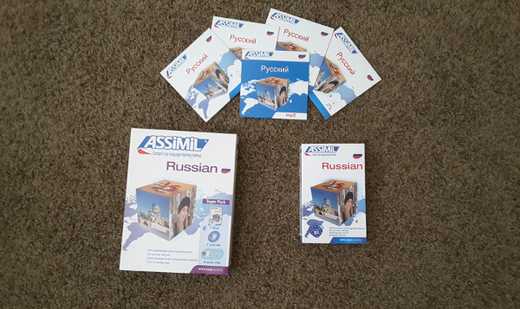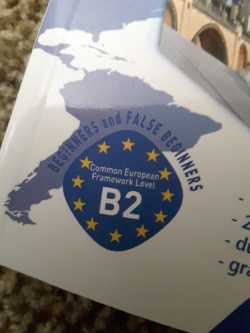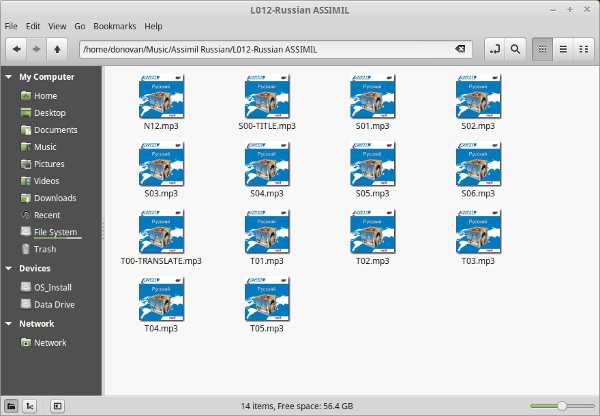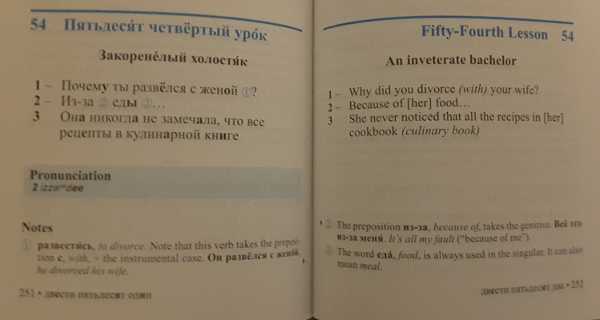The Most Honest Assimil Review You'll Ever Read
 Written byHubert Nagel
Written byHubert Nagel- Read time14 mins
- Comments54


- High quality dialogues
- Perfectly arranged audio library
- Very comprehensive
- Translation-based
- Doesn't appear to be backed by research or case studies
- Unusual and bizarre situational topics
The Assimil method is old and outdated, and its ‘two wave’ approach has little value in light of current Second Language Acquisition trends (although its focus on patterns rather than grammar drills is ahead of its time). The Assimil dialogues are extremely useful, however.
NOTE: Be sure to check out my Essential Language Learning Tools page for other alternatives to Assimil.
I use and recommend this course as a more comprehensive online audio resource (multiple languages).
After a lot of years of sampling and reviewing just about every major language product (and some hopefuls) on the market, I finally sat down this week to put the famous Assimil series under the microscope.
I’ve put it off until now for one main reason:
It’s surprisingly difficult to get hold of outside of Europe.
When I have been lucky enough to find one of their editions on a shelf somewhere, it’s unfortunately been for a language that I’m not learning.
In particular, I wanted to get an Assimil Super Pack (pictured above) in one of my languages which includes the book, CD’s and MP3 CD (with English rather than French as the base language).
Although some Assimil editions can be found on Amazon, they’re priced outrageously high compared to the main site. In the end the best option I had was to order the Russian Edition directly from the Assimil website itself (to give you an idea of the price difference, on Amazon it currently sells for $195 and on the Assimil site it’s about $75!).
The entire website is in French however with no English order form.
I’ve been eager to sit down and spend time on Assimil because I know how popular it is in the online ‘polyglot community’, promoted by various well-known language learners and the language learning subreddit.
Unfortunately (as with other products), I spent hours trawling online for ‘Assimil reviews’ and found nothing of substance. Just about every written and video review I found was a total waste of energy (usually just “reviewers” flipping through a book saying how pretty it looks). No real attention given to the content or method itself.
Of course, these phony reviews aren’t going to help anyone make a decision on whether or not to use it.
So today I’ve given the series the time it deserves and tried to provide you with a detailed and balanced review of the Assimil method.
I fired off two questions to the team over at Assimil and received their response so I’m going to share my own discovery and perspective based on those answers.
Have you or do you use Assimil? Share your thoughts in the comments below!
1. Is the Assimil Method based on any research data or empirical evidence?
Very difficult question.
We have really little information about the way Alphonse Chérel created his method. All we can say is that Alphonse Chérel knew that there was no product/book/method for a large audience that could be used individually.
He was a visionary because he understood that self-learning was some kind of modern thing related to a growing individualistic trend in European societies.
A more personal thought: I find some similarities between Assimil’s pedagogy and Hermann Ebbinghaus’ work on memory, learning and forgetting curves. Ebbinghuas‘ ideas were pretty famous in Europe at the time Alphonse Chérel was preparing his own method.
– Nicolas Ragonneau, Assimil
I have to say I was stunned and disappointed by this response.
It shouldn’t be a difficult question for them to answer.
I find it truly fascinating that even the Assimil company itself does not know much about its own product or method and has no way of referencing empirical data or evidence to explain how it works, successful outcomes or how it was developed.
I‘ve only ever seen anecdotal assurances with Assimil.
What they do seem to know is that Assimil was created to fill a market gap at the time for *autodidactic learners (people who learn on their own). The creator of Assimil is a mystery even to the people who represent his work and company.
This is in stark contrast to a product like Pimsleur for example where the founder (Paul Pimsleur) and his method are very well documented with lots of supportive evidence and data.
For this reason it’s hard to have much confidence in the effectiveness of Assimil’s method from the outset.
As for the side note, I’m sure that Ebbinghaus was an influential contemporary. However I personally can’t see any direct correlation between his work and Chérel‘s to warrant suggesting that Assimil was maybe/possibly/kinda heavily influenced by or related to it.
It still doesn’t explain Chérel‘s peculiar method either way.
On the Assimil website under ‘La Méthode’, the steps of the Assimil method are briefly outlined and followed by one simple assurance:
“Vos résultats vous surprennent.” (Your results will surprise you.)
To me that’s a bit like saying, ‘we have no idea where this method came from or research to back it up but trust us, it’s awesome!’. :)
So what is the method or process it outlines exactly?
Each Assimil ‘course’ provides 100 lessons with accompanying audio, English (or French) native language translation, footnotes explaining a few grammar and pronunciation points, and some translation exercises.
The Assimil method is comprised of two “phases” or “waves”.
Phase one, the passive phase, involves reading, listening to and repeating the first 49 lessons of the book without attempting to translate the material back into English (or French). The reader is assured that by doing so, the phrases will “sink in” naturally.
The number of lessons (49) for the passive phase appears to be an arbitrary choice based solely on the fact that it’s half way through the book rather than anything else. There also isn’t a very clear progression in terms of ascending difficulty, as some later lessons/topics are technically much easier than earlier ones (although the audio recordings do speed up as you progress).
Once the 50th lesson has been reached, the active phase begins.
This requires you to start back at lesson 1 and (this time) actually complete the translation exercises as you continue to move through the book.
Herein lies a crucially important and problematic point:
Translation is at the heart of Assimil’s method.
It’s also their measure of determining acquired spoken fluency.

There’s a B2 label on the front of my Russian Edition indicating/claiming that by completing the book, I will reach a B2 equivalent in Russian according to the CEFR scale. Well unless they’re referring specifically to literacy (rather than spoken) skills, then that’s false.
You simply cannot become a B2 level ‘speaker’ of anything by reading and translating text. Period.
That would be like suggesting you can become a professional violinist by reading sheet music.
You‘re training a different skill.
As I say all the time, translation approaches to language learning are thoroughly outdated (remember that Assimil was made back in 1929!) and these increasingly obsolete approaches are ineffective at producing fluent speakers. As a language educator, I’ve traveled the world and met many students all over who were taught this way with English using outdated methodology, and while having an incredible grasp of the written language, are unable to communicate in a basic A1 level conversation.
In fact I would argue that one of the characteristics of functional spoken fluency is being able to communicate without translating.
One other point worth noting is that Assimil also states that 20-30 minutes a day for “just a few months” (as long as it’s every day) is sufficient to complete the course and achieve fluency (in the case of my Russian Edition, to reach a B2 equivalent).
You’ll be speaking naturally “without hesitation” it says.
Nonsense. That’s totally insufficient.
To make no mention of actually using the language with people and to claim that half an hour of book study a day is all you need to become a high level speaker is demonstrably false.
Again, the problem with claims like this is that there is no research available to verify Assimil’s claims or even to show where Chérel came up with it.
I know that in my own experience learning many languages over the past decade, I can confidently say that a spoken B2 equivalent in any language takes a serious, long-term and intensive time commitment.
30 minutes a day over a few months translating sentences on paper just doesn’t cut it.
2. What is it about Assimil that sets it apart from other language book series and methods (e.g. Teach Yourself and Michel Thomas)?
First of all, Assimil is an older imprint than TY [Teach Yourself] and MT [Michel Thomas]. Assimil was created in 1929.
Secondly, Assimil is inevitably different because it was originated by a single man, Alphonse Chérel, who was unique (as every human on this planet). So there is a strong idiosyncrasy in the Assimil method.
And last, the beginning of the Assimil method is based on the idea of transparent words (‘My tailor is rich‘, the first sentence of the English method, may be absurd, but it is so close to the French sentence ‘mon tailleur est riche’ !).
Of course the limit to this starting point is the distance between some languages (it works very well for Indo-European languages, it’s not as obvious when you come to Arabic and Basque!)
– Nicolas Ragonneau, Assimil
The point made there that the Assimil method “is based on the idea of transparent words” is very interesting.
For languages so closely related to English like French, this is indeed a great starting point. But as Nicolas alluded to, for languages that are far removed from English, the same process doesn’t work at all.
This actually makes me wonder if the Assimil method is only beneficial for closely related languages.
If the method itself was designed to help you identify similar patterns and structures then that would make it utterly useless for languages like Arabic or Mandarin Chinese.
In Assimil’s defense, one thing that I think is wonderful (and really ahead of its time back in the 20’s) is that it focuses more on identifying and translating patterns rather than grammar.
What that means is that unlike typical courses which begin with a grammar point and then reinforce that grammar point with dialogues and exercises, Assimil has a strong emphasis on lexical chunk acquisition (e.g. learning whole phrases) which my readers know I’m a huge proponent of (see here and here).
This was popularized by Michael Lewis’ Lexical Approach in English language methodology and has been hugely influential on my own learning.
As anyone who follows me knows, I always teach that a grammar-first approach to language learning is unnatural and backward.
It’s also the reason why foreign language education all over the world has been failing miserably.
It isn’t how we learn our first language and it shouldn’t be how we learn our second either. See my article titled ‘You Don’t Need To Study Grammar To Learn To Speak A Foreign Language‘ where I explain this in detail.
In the Assimil series, grammar explanations are a mere footnote.
They’re also not exhaustive.
Instead, Assimil focuses on presenting you with complete, useable expressions and even the translation exercises which I mentioned above are for whole phrases rather than grammar drilling.
This means that instead of providing you with conjugation and declension tables, and then telling you to memorize them, you’re given natural sentences in the context of many different scenario**s along with the English equivalent.
Assimil is more like a graded phrasebook or interlinear with footnotes.
You’re expected to just listen and repeat.
For example, you’re given an expression (in the Russian Edition) like ‘Какой ужас!’ and its corresponding meaning *‘How awful!’ with no actual explanation of its grammar. You’re just expected to read it, listen to how it’s said and repeat it the same way in similar contexts.
This is excellent.
Explanations are usually what cause the most confusion in language learning and in my opinion you’re better off following Assimil’s lead to ‘listen and repeat’ without digging too deep in the ‘whys’ and ‘hows’.
This is something I advocate constantly.
How to get the most out of Assimil
The reason why I chose to buy the Super Pack which contains the MP3 CD as well as the audio CD’s is that the MP3’s are recorded for each individual expression.

Each line of every dialogue is separated (e.g. S01.mp3, S02.mp3 and so on).
So the example I gave above of ‘Какой ужас!’ is recorded as its own MP3 file in the Super Pack.
I found this incredibly convenient as I usually have to create my own audio files for learning using tools like Audacity which is very time-consuming.
Assimil has done this for me.
I can then put those short expressions into a tool like Anki to make flashcards using the audio with images or text, or I can just play them on repeat.
Many of the situational dialogues in Assimil appear completely random and strange, and are not going to be useful to most people in most circumstances. For example, there’s a lesson called ‘The Thief’ which includes a dialogue between a lawyer and a defendant – unless you’re planning to commit a crime it’s an odd scenario to include.
There’s a lesson called “An Inveterate Bachelor” where a guy talks about divorcing his wife because he doesn’t like her cooking.

And there’s another lesson on the sounds that cats and dogs make.
These are just a few examples of the kind of bizarre and unnecessary scenarios the book presents.
However… they’re not entirely useless.
If you take a look at the dialogues of those odd situations, you can take out expressions that you know you’d find useful in other situations.
A big part of language learning is searching for high-frequency expressions that you use a lot and are personally relevant.
So in the case of the ‘The Thief’ lesson (which is a situation I hopefully will never find myself in – especially in Russia! :)), there are expressions like ‘Ну, и что?’ (So what?) and ‘Как вам не стыдно?’ (You should be ashamed of yourself/How are you not ashamed?).
These are situational expressions that I could find useful in many other scenarios.
So I take those expressions, use the MP3 files provided and discard the rest of the dialogue (perhaps until another time).
Instead of spending lots of time and energy learning content that I may never ever need, I’m very selective about learning only the things that I will find useful.
Make sense?
This is how I’m using Assimil, despite its peculiar topics and outdated methodology, and still getting tonnes of use out of it.
I’m not interested in the two phase method of Assimil because I don’t see it as an efficient use of my time to translate text – especially when a lot of topics are totally irrelevant or weird.
Thankfully the quality of the recorded audio is outstanding (at least for the Russian Edition I have) so it’s an excellent source of material no matter how I use it.
The verdict: Is Assimil as great as people say it is?
I have mixed feelings about Assimil but I think the best way for me to sum it up is like this:
The Assimil material/content is excellent and very useful.
But the Assimil Method is not.
The method is old and outdated, and therefore I don’t believe its ‘two wave’ approach has much value in light of current SLA trends (although its focus on *patterns rather than grammar drills is ahead of its time).
However, the dialogue material and recordings (especially the way they’re separated and presented on the MP3 CD) are among the best I’ve seen in any book course.
So overall it’s an extremely useful resource for those of us who are good at directing our own learning but for anyone wanting a book or course that ‘walks you through’ everything, Assimil is (in my opinion) not a suitable choice.
Final note on the price: in most cases, you’re probably better off avoiding Amazon altogether and using the Assimil website to order it. As I mentioned up top, the Russian Edition was well over $100 cheaper ordering it direct.
UPDATE: In response to this post, I received another email from Assimil. Here’s part of it:
La méthode Assimil is also called the intuitive method, which means you learn without even understand why you learn. But for me Alphonse Chérel had also some kind of intuition when he did that. Call this serendipity, call this whatever you want.
As far as I know Alphonse Chérel hasn’t left any written memo about the way he worked at the beginning. But this doesn’t mean we do not know how it works at all.
There is also a kind of strong tropisme in the méthode, which was created against the official ways of learning in school. From this point of view, Assimil was very disruptive at that time.
But you have to be French or to be raised in France to understand this.
I mean we do not know how it works at a scientific level. I dream of working with neuroscientists to understand what happens in the brain, but we’d need time and money to do this.
Maybe one day.
Have you used Assimil? Share your thoughts below!
 Grab the link to this article
Grab the link to this article